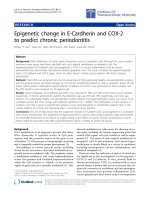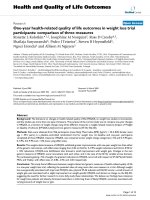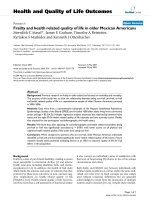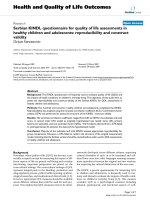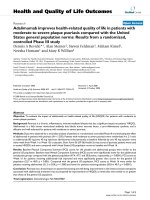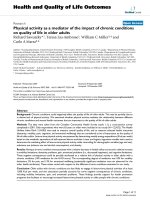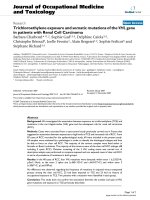báo cáo hóa học:" Evaluating change in health-related quality of life in adult rhinitis: Responsiveness of the Rhinosinusitis Disability Index" potx
Bạn đang xem bản rút gọn của tài liệu. Xem và tải ngay bản đầy đủ của tài liệu tại đây (300.66 KB, 11 trang )
BioMed Central
Page 1 of 11
(page number not for citation purposes)
Health and Quality of Life Outcomes
Open Access
Research
Evaluating change in health-related quality of life in adult rhinitis:
Responsiveness of the Rhinosinusitis Disability Index
Hubert Chen*
1,2
, Patricia P Katz
1,3
, Stephen Shiboski
4
and Paul D Blanc
1,2
Address:
1
Department of Medicine, University of California, San Francisco (UCSF), CA, USA,
2
Cardiovascular Research Institute, UCSF, CA, USA,
3
Institute for Health Policy Studies, UCSF, CA, USA and
4
Department of Biostatistics and Epidemiology, UCSF, CA, USA
Email: Hubert Chen* - ; Patricia P Katz - ; Stephen Shiboski - ;
Paul D Blanc -
* Corresponding author
Abstract
Background: The Rhinosinusitis Disability Index (RSDI) is a validated measure of health-related
quality of life (HRQL) in rhinitis. Responsiveness of the RSDI to changes in health status over time
has not been described.
Methods: We studied adults with a self-reported physician diagnosis of rhinitis identified through
a national telephone survey. HRQL was assessed at baseline and at 24 months using the RSDI.
Symptom severity, physical health status (SF-12 PCS), psychological mood (CES-D), and perceived
control of symptoms were also assessed at the time of each interview. In addition, we ascertained
specific health outcomes attributed to rhinitis, including days of restricted activity, job effectiveness,
number of physician visits, and medication costs.
Results: Of 109 subjects interviewed at baseline, 69 (63%) were re-interviewed 24 months later.
RSDI scores improved by = 0.5 standardized response mean in 13 (19%) subjects and worsened in
17 (25%). Change in the RSDI over time correlated with changes in symptom severity (r = 0.38, p
= 0.001), physical health (r = -0.39, p = 0.001), mood (r = 0.37, p = 0.002) and perceived control
of symptoms (r = -0.37, p = 0.01). In multivariate analyses adjusted for baseline health status,
improvement in RSDI was associated with less restricted activity (p = 0.01), increased job
effectiveness (p = 0.03), and decreased medication costs (p = 0.05), but was not associated with
change in the number of physician visits from baseline (p = 0.45).
Conclusion: The RSDI is responsive to changes in health status and predicts rhinitis-specific health
outcomes.
Background
Rhinitis is a common chronic condition and can be a sig-
nificant source of impairment. To measure the impact of
rhinitis on health-related quality of life (HRQL), several
disease-specific measures have been developed [1,2].
These instruments vary in length and content. Certain
instruments, such as the 28-item Juniper Rhinoconjuncti-
vitis Quality of Life Questionnaire (RQLQ), were origi-
nally intended to focus on persons with allergic disease
[3]. Other instruments, such as the 16-item Sino-Nasal
Outcome Test (SNOT-16), focus more on conditions
characterized by chronic nasal obstruction, typically
sinusitis [4].
Published: 08 November 2005
Health and Quality of Life Outcomes 2005, 3:68 doi:10.1186/1477-7525-3-68
Received: 24 June 2005
Accepted: 08 November 2005
This article is available from: />© 2005 Chen et al; licensee BioMed Central Ltd.
This is an Open Access article distributed under the terms of the Creative Commons Attribution License ( />),
which permits unrestricted use, distribution, and reproduction in any medium, provided the original work is properly cited.
Health and Quality of Life Outcomes 2005, 3:68 />Page 2 of 11
(page number not for citation purposes)
The Rhinosinusitis Disability Index (RSDI), another
measure of HRQL, has been used both in persons with
allergic disease as well as in those with chronic nasal
obstruction [5,6]. The instrument has 30 items compris-
ing three domains: physical, functional, and emotional.
Internal consistency and test-retest reliability of the instru-
ment were initially described in 87 patients with a physi-
cian's diagnosis of rhinitis or rhinosinusitis [5]. The RSDI
has subsequently been applied in larger populations
across a spectrum of rhinologic diagnoses, ranging from
allergic rhinitis to chronic sinusitis [6].
In a previous analysis, we evaluated the performance of
the RSDI cross-sectionally in 109 adults with predomi-
nately allergic disease [7]. We found that the RSDI corre-
lated in the expected ways with other measures of physical
and mental health status, providing good evidence of con-
struct validity. Furthermore, we found that psychosocial
factors, such as the perception of one's own ability to deal
with his or her nasal condition (termed 'perceived control'),
can also play a large role in determining quality of life in
rhinitis.
Although the discriminative properties of the RSDI have
been studied in a cross-sectional fashion, its responsive-
ness to changes in health status has not been established.
Responsiveness describes the ability of an instrument to
capture meaningful changes in health over time. To dem-
onstrate responsiveness, the same instrument must be
administered at least twice over a given period of time.
Responsiveness, however, differs from test-retest reliabil-
ity. Test-retest reliability is measured by re-administering
the same instrument within a short time interval during
which the subject's health status remains unchanged. In
contrast, responsiveness is typically demonstrated over
longer intervals during which the subject's health status
might reasonably have changed in some relevant way.
Responsiveness has important implications for instru-
ments used in clinical trials, where investigators are often
trying to measure a clinically meaningful change before
and after an intervention. In addition, it is also relevant in
the study of disease progression or remission.
To determine the responsiveness of the RSDI, we studied
change in HRQL in 69 adults with rhinitis using data col-
lected over a 24-month period. Cross-sectional results of
the 109 subjects studied at baseline have previously been
reported [7]. Responsiveness of the RSDI was tested rela-
tive to other health status measures simultaneously
administered to assess symptom severity, physical func-
tioning, mood, and perceived control of symptoms. We
then used the RSDI to evaluate the relationship between
change in HRQL and other rhinitis-specific health out-
comes.
Methods
Overview
We used data collected as part of a prospective, longitudi-
nal cohort study of adults with asthma and rhinitis. We
assessed change in HRQL and health status among 69
subjects with rhinitis alone (without concomitant
asthma) who participated in two consecutive interview
waves conducted approximately 24 months apart. We
evaluated responsiveness of the RSDI relative to other
generic and disease-specific health status measures simul-
taneously assessed. We also evaluated how change in dis-
ease-specific HRQL, measured by RSDI, was related to
change in other rhinitis-specific health outcomes, includ-
ing restricted activity, job effectiveness, physician visits,
and medication costs.
Subject selection
Subject data were drawn from a larger prospective study of
persons with asthma, rhinitis, or both. Details of recruit-
ment and subsequent interview waves have been previ-
ously reported [8]. In brief, we enrolled English- and
Spanish-speaking subjects aged 18 to 50 years from the
Northern California region via random-digit dialing.
Approval for the study of human subjects was obtained
from the University of California, San Francisco Commit-
tee on Human Research.
We used data from interviews conducted in 2000–1 (base-
line for this study) and 2002–3 (follow-up for this study).
Subjects were included in our analysis if they reported a
physician's diagnosis of allergic rhinitis, sinusitis, hay
fever, or chronic post nasal drip, without concomitant
asthma. One hundred nine subjects completed the rhini-
tis component of our health survey at baseline, of which
69 (63%) were re-interviewed at follow-up.
Health status measures
Rhinosinusitis Disability Index (RSDI)
To measure disease-specific HRQL in rhinitis, we used the
RSDI, a 30-item questionnaire developed for use in per-
sons with nasal or sinus disease [5]. Each item is rated on
a 5-point Likert scale ranging from 'never' (scored as 0) to
'always' (scored as 4). The total score possible, calculated
by summing the individual items, ranges from 0 to 120,
with higher scores reflecting worse HRQL. The RSDI has 3
subscale domains: physical (11 items), functional (9
items), and emotional (10 items). The individual items
comprising each of these domains are shown in Addi-
tional file: 1. Its reliability and validity have been demon-
strated in patients with various rhinologic conditions [6].
In our analysis of subjects at baseline, the RSDI demon-
strated high internal consistency with a Cronbach's alpha
of 0.97 [7].
Health and Quality of Life Outcomes 2005, 3:68 />Page 3 of 11
(page number not for citation purposes)
Rhinitis Symptom Score (RSS-4)
To measure symptom severity in rhinitis, we used four
items drawn from a previously validated 31-item symp-
tom scale for rhinoconjunctivitis and asthma developed
by Wasserfallen et al [9]. The specific items included in
our rhinitis questionnaire assessed four types of symp-
toms: 'sensation of fullness, congestion or blockage of the
nose', 'sneezing', 'sinus headache or pain in face', and
'postnasal drip in back of throat'. Symptoms were rated on
a 5-point Likert scale. Scores for the individual items were
totaled yielding a possible range of 0 to 16, with higher
score reflecting greater symptom severity. Using this 4-
item symptom scale in our baseline analysis, we observed
good internal consistency with a Cronbach alpha of 0.81.
The Short Form 12 (SF-12)
To measure general physical functioning we used the
physical component summary (PCS) of the SF-12. The SF-
12 consists of 12 items drawn from the widely used Short
Form 36 (SF-36). The reliability, validity, and responsive-
ness of the SF-12 have been demonstrated in various dis-
ease states, and are comparable to those of the SF-36 [10].
SF-12 PCS scores range from 0 to 100, with a general pop-
ulation mean of 50 ± 10 (SD). Higher scores reflect better
physical functioning.
Center for Epidemiologic Studies Depression scale (CES-D)
The CES-D consists of 20 items originally intended to
assess depressive symptoms [11]. Further evidence, how-
ever, suggests that the CES-D also measures general psy-
chological factors in addition to depression[12,13] For
this reason, we refer to the CES-D as assessing 'psycholog-
ical mood'. CES-D scores range from 0 to 60, with higher
scores reflecting worse mood.
Perceived Control of Rhinitis Questionnaire (PCRQ)
Psychosocial factors such as an individual's perception of
his or her ability to deal with illness, referred to as per-
ceived control, have been demonstrated to be an impor-
tant correlate of health status, both in rhinitis and asthma
[7,14], as well as other chronic conditions [15]. To meas-
ure perceived control, we used the 8-item PCRQ. PCRQ
scores range from 8 to 40, with higher scores reflecting
greater perceived control of rhinitis. We previously vali-
dated this instrument in a cross-sectional analysis of our
baseline data [7]. Similar instruments, upon which it is
based, have also been validated for use in asthma [14].
Disability, health care utilization, and medication costs
Other rhinitis-specific health outcomes assessed included
job effectiveness and restricted activity over the 4 weeks
prior to interview, and physician visits and medication
costs over the 12 months prior to interview. Job effective-
ness, in terms of the specific impact of the subject's nasal
condition, was assessed on a scale of 0 to 100% (0%
meaning unable to work at all and 100% meaning work
not affected). Restricted activity was reported as the
number of days restricted due to subject's medical condi-
tion. Physician visits were reported as the number of visits
made specifically for a nasal condition, excluding routine
visits for allergy desensitization. Out-of-pocket health
costs were assessed separately for prescription and over-
the-counter rhinitis medications. Subjects were asked to
choose from four possible cost ranges: 'less than $10',
Table 1: Subject characteristics of 109 adults with rhinitis interviewed at baseline
Re-interviewed at 24 months
Baseline characteristics Yes (n = 69) No (n = 40) p value
Age, mean ± SD 40 ± 8.2 37 ± 8.6 0.16
Female, n (%) 44 (64) 30 (75) 0.23
White (non-Hispanic), n (%) 50 (72) 30 (75) 0.77
Education, n (%) 0.36
High school or less 10 (14) 8 (20)
Some college 47 (68) 27 (68)
Graduate degree 12 (17) 5 (13)
Married, n (%) 44 (64) 23 (58) 0.52
Income <$40,000/y, n (%) 10 (14) 12 (30) 0.05
Smoking status, n (%) 0.46
Never 43 (62) 22 (55)
Former 15 (22) 10 (25)
Current 11 (16) 8 (20)
Self-rated severity of rhinitis, n (%) 0.95
Mild 24 (35) 14 (34)
Moderate 35 (51) 19 (48)
Severe 10 (14) 7 (18)
Health and Quality of Life Outcomes 2005, 3:68 />Page 4 of 11
(page number not for citation purposes)
'$10 to $99', '$100 to $1,000', or 'more than $1,000'. For
the purpose of our analysis, we assigned subjects to the
median value for each response category (e.g. $45 for '$10
to $99'), using $1000 for the highest category. A single
cost variable was then calculated by summing costs for
prescription and over-the-counter medications.
Statistical analyses
Comparisons between subjects who completed a follow-
up interview (n = 69) with those who had not (n = 40)
were made using t test for continuous variables, Chi-
square test for dichotomous variables, and Chi-square test
for trend for ordinal variables. Mean (±SD) summary
scores were calculated for each health status measure at
baseline and 24-month follow-up. Change was calculated
by subtracting baseline scores from scores at follow-up
and expressed as standardized response means (SRM).
The SRM equates to the overall observed change divided
by the standard deviation of the individual observed dif-
ferences in score for the entire group. For the RSDI, a neg-
ative change in score reflects improved HRQL over time,
whereas a positive change in score reflects worsened
HRQL. To evaluate for changes in the RSDI within indi-
viduals, we used the paired t test.
We examined responsiveness of the RSDI in two separate
ways. First, we evaluated change in the RSDI score relative
to change in the other health status measures delineated
above (RSS-4, SF-12 PCS, CES-D, and PCRQ), treating all
variables as continuous. Pearson correlations were used to
make these comparisons, as changes in scores approxi-
mated normal distributions for all health measures stud-
ied. As an alternative analysis, we categorized subjects into
three groups, 'better', 'same', or 'worse', based on change
in each health status measure. We used a change quanti-
fied as one standard error of measurement (SEM) or
greater as the criterion for a difference great enough to be
consistent with a minimal clinically important difference
(MCID). Evidence by Wywrich and others supports use of
one SEM (calculated as the standard deviation of the
instrument multiplied by the square root of one minus its
reliability coefficient) as an approximation of the MCID
[16]. By inference, this should also be a reasonable gauge
of a substantive difference in score over time. Thus using
this categorization scheme, we calculated SEM-based
MCIDs for the RSS-4, SF-12 PCS, CES-D, and PCRQ.
Based on these cut-offs, we defined subjects as 'same'
(absolute change in score <1 SEM), 'better' (score
improved by ≥1 SEM), or 'worse' (score worsened by ≥1
SEM) for each measure. Mean change in RSDI was com-
pared among the groups, first using one-way ANOVA to
detect an overall difference, then using Tukey's t test to
perform multiple comparisons (when ANOVA was signif-
icant at p < 0.05). We repeated this analysis for each
health status measure to which the RSDI was compared
(RSS-4, SF-12 PCS, CES-D, and PCRQ).
Finally, we used linear regression to evaluate the relation-
ship between change in HRQL, as measured by the RSDI,
and change in rhinitis-specific health outcomes (disabil-
ity, health care utilization, and medication costs). We first
evaluated each health outcome in a bivariate model with
change in RSDI score as the independent variable. We
then performed multiple linear regression adding base-
line RSS-4, SF-12 PCS, CES-D, and PCRQ as covariates in
the model, in order to take into account each subject's
health status at baseline. Effect estimates are expressed as
change in the health outcome variable (days of restricted
activity, percent change in job effectiveness, number of
visits, or dollars spent for medications) per 1.0 SRM
change in the RSDI score. All analyses were performed
using SAS System for Windows release 8.02.
Results
Subjects characteristics
Overall, the 69 subjects studied were predominately
female, white (non-Hispanic), and well-educated, with
predominately moderate to severe self-rated rhinitis
Table 2: Change in health-related quality of life and health status among 69 adults with rhinitis
Measure Baseline (mean ± SD) 24 month follow-up
(mean ± SD)
Observed change*
(mean ± SE)
Standardized response
mean
†
p value
‡
RSDI – Total 23.3 ± 23.4 24.6 ± 24.0 1.3 ± 2.7 0.06 0.63
Physical 11.2 ± 10.6 10.7 ± 9.6 -0.4 ± 1.2 -0.04 0.72
Functional 5.6 ± 7.0 6.5 ± 7.5 0.9 ± 0.9 0.13 0.28
Emotional 6.6 ± 7.7 7.3 ± 8.4 0.8 ± 1.0 0.10 0.42
RSS-4 6.9 ± 4.6 5.4 ± 3.9 -1.5 ± 0.5 -0.31 0.01
CES-D 10.5 ± 10 11.5 ± 9.9 1.0 ± 1.3 0.09 0.43
SF-12 PCS 48.2 ± 8.6 47.8 ± 9.0 -0.5 ± 1.0 -0.05 0.65
PCRQ 27.7 ± 4.8 28.8 ± 5.2 1.2 ± 0.7 0.21 0.09
RSDI = Rhinosinusitis Disability Index; RSS-4 = 4-item Rhinitis Symptom Score; CES-D = Center for Epidemiologic Studies Depression scale; SF-12
PCS = Short Form 12 Physical Component Summary; PCRQ = Perceived Control of Rhinitis Questionnaire. * Observed change = (score at follow-
up) - (score at baseline). † Standardized response mean = [(score at follow-up) - (score at baseline)/(SD of observed change)]. ‡ Paired t test
Health and Quality of Life Outcomes 2005, 3:68 />Page 5 of 11
(page number not for citation purposes)
(Table 1). Baseline characteristics of those subjects re-
interviewed were not significantly different that those
who were not, with the exception of income. Subjects not
re-interviewed were more likely to have an annual family
income of less than $40,000.
Change in HRQL and health status
The change in HRQL over follow-up approximated a nor-
mal distribution, with the majority of subjects demon-
strating a change of less than 0.5 SRM (Figure 1). The
RSDI decreased by 0.5 SRM or more (better HRQL) in 13
(19%) subjects and increased by 0.5 SRM or more (worse
HRQL) in 17 (25%). Overall, RSDI scores for the group as
a whole did not change significantly (Table 2). Similarly,
no statistically significant differences were observed in
any of the RSDI subscales.
Changes in symptom severity, physical functioning,
mood, and perceived control also approximated normal
distributions. Rhinitis symptom severity, as measured by
the RSS-4, improved by a small, though significant, incre-
ment (Table 2). The remaining health status measures
(SF-12 PCS, CES-D, and PCRQ) demonstrated no statisti-
cally significant changes at the group level.
Responsiveness to changes in health status
Change in the RSDI at the individual level correlated
moderately well with changes in the RSS-4, SF-12 PCS,
CES-D, and PCRQ. Moreover, changes were in the antici-
Change in health-related quality of life (HRQL) over 24 months in 69 adults with rhinitisFigure 1
Change in health-related quality of life (HRQL) over 24 months in 69 adults with rhinitis. Width of each bar rep-
resents one standardized response mean (SRM) calculated as the mean observed change divided by the standard deviation of
the observed change. A negative change in RSDI score reflects better HRQL, whereas a positive change in score reflects worse
HRQL.
1
5
7
39
14
3
0
0
10
20
30
40
50
>
-
2.
5
-
1.5 to
-
2.5
-0.5 to -1.5
-0.5 to 0.5
0.
5
t
o
1
.
5
1.
5
t
o
2
.
5
> 2.5
Change in RSDI
(measured as SRM)
Number of subjects
better HRQL worse HRQL
Health and Quality of Life Outcomes 2005, 3:68 />Page 6 of 11
(page number not for citation purposes)
pated directions (Table 3). Specifically, better HRQL, as
measured by the RSDI, was associated with lower symp-
tom severity, greater physical functioning, better mood,
and greater perceived control. Similar correlations were
observed for each of the RSDI subscales.
We reanalyzed these relationships, categorizing subjects
based on change in health status as measured by the RSS-
4, SF-12 PCS, CES-D, and PCRQ. Mean RSDI scores
improved (negative change in score) in subjects catego-
rized as 'better' with respect to symptom severity (RSS-4),
physical functioning (SF-12 PCS), mood (CES-D), and
perceived control (PCRQ) (Figure 2). Similarly, mean
RSDI scores worsened (positive change in score) in sub-
jects categorized as 'worse' according to the other health
status measures. In all cases, observed changes in the RSDI
were statistically significant compared to subjects catego-
rized as the 'same' relative to baseline.
These same results are presented again in an alternative
format in Figure 3, showing categorical change in the
RSDI versus categorical change in the other health status
measures. Highly discordant change between measures
(for example, 'better' versus 'worse') was observed in
approximately one in every 10 subjects: 4 (6%) subjects
for the symptom severity (RSS-4), 6 (9%) subjects for
physical functioning (SF-12 PCS), 9 (13%) subjects for
mood (CES-D), and 7 (10%) subjects for perceived con-
trol (PCRQ).
Relationship with self-reported health outcomes
Change in HRQL, as measured by the RSDI, was signifi-
cantly associated with change in days of restricted activity,
altered job effectiveness, and incremental medication
costs, but was not associated with differing frequency of
physician visits relative to baseline (Table 4). After adjust-
ing for baseline health status (RSS-4, SF-12 PCS, CES-D,
and PCRQ), these observed associations for activities,
effectiveness and medication costs remained statistically
significant. In these multivariate analyses, an increase in
RSDI score of 1.0 SRM (22.3 points) was associated with
an increase of nearly 2.5 days of restricted activity per
month, a decrease of >4% in job effectiveness, and an
increase of >$78 spent on rhinitis medications per year.
Discussion
In this study, we demonstrate that the RSDI is responsive
to changes in health status over time, and thus can be used
to measure longitudinal change in HRQL in rhinitis.
Change in HRQL, as measured by the RSDI, correlated in
the expected ways with changes in symptom severity,
physical functioning, mood, and perceived control of
symptoms. In addition, we found that change in HRQL
was associated with changes in rhinitis-specific health
outcomes, specifically days of restricted activity, job effec-
tiveness, and medication costs, even after controlling for
health status at baseline.
Although several measures of HRQL have been developed
for rhinitis and sinusitis, few have undergone rigorous
psychometric testing [2]. In order for an instrument to be
useful, it should be valid, reliable, and responsive. A sys-
tematic review by Linder et al. identified 16 instruments
used to measure HRQL in sinusitis, of which only three
instruments met basic requirements for validity, reliabil-
ity, and responsiveness: the Chronic Sinusitis Survey –
Duration-based (CSS-D), the Rhinosinusitis Outcome
Measure-31 (ROM-31), and the SNOT-16 [17]. Addition-
ally, the Juniper RQLQ has also been shown to demon-
strate strong measurement properties, particularly in
patients with allergic rhinitis [18].
This study focuses on demonstrating the responsiveness
of the RSDI, which has yet to be reported. We believe that
this is important because the RSDI is useful across a range
of rhinologic conditions, is reasonably short in length,
and is structured in a way that facilitates telephone admin-
istration. These attributes that make the RSDI particularly
suitable for repeated administration in longitudinal sur-
vey research where the ability to measure change is often
desired.
Responsiveness can be determined in a number of ways,
but must include some type of longitudinal assessment
Table 3: Correlations between change in the RSDI and change in other health status measures
∆ RSS-4 ∆ SF-12 PCS ∆ CES-D ∆ PCRQ
∆ RSDI – Total 0.38 (0.16, 0.57) -0.39 (-0.57, -0.16) 0.37 (0.15, 0.56) -0.37 (-0.56, -0.14)
Physical 0.32 (0.09, 0.52) -0.37 (-0.55, -0.14) 0.31 (0.08, 0.51) -0.30 (-0.50, -0.07)
Functional 0.39 (0.17, 0.58) -0.45 (-0.62, -0.23) 0.39 (0.17, 0.57) -0.39 (-0.57, -0.17)
Emotional 0.33 (0.10, 0.52) -0.23 (-0.44, 0.01) 0.31 (0.08, 0.51) -0.32 (-0.51, -0.09)
Values represent Pearson correlation coefficients (95% confidence interval). RSDI = Rhinosinusitis Disability Index; RSS-4 = 4-item Rhinitis
Symptom Score; CES-D = Center for Epidemiologic Studies Depression scale; SF-12 PCS = Short Form 12 Physical Component Summary; PCRQ =
Perceived Control of Rhinitis Questionnaire. ∆ = Change over 24 month follow-up.
Health and Quality of Life Outcomes 2005, 3:68 />Page 7 of 11
(page number not for citation purposes)
[19]. There are two general approaches to interpreting
change in HRQL, a 'distribution-based' approach (also
referred to as 'internal responsiveness') and an 'anchor-
based' approach (also referred to as 'external responsive-
ness') [20,21].
The 'distribution-based' approach relies entirely on the
statistical distribution of the results, using effect size or
SRM as a method for assessing change. For our initial
analysis, we adopted this approach to summarize global
changes in the RSDI, expressing the difference in scores as
standardized response means (Figure 1), and testing the
difference using paired t test (Table 2). The main criticism
of relying solely on a 'distribution-based' approach is that
there is no standard by which to judge whether the
changes observed are in fact important to the patient or
clinically meaningful. Often this approach is used in clin-
ical trials involving an intervention that is believed to be
efficacious. The RSDI has only been used in two clinical
trials, neither of which purported to directly assess the
responsiveness of the instrument. In one trial evaluating
the efficacy of hypertonic saline nasal irrigation, RSDI
scores improved by 6.0 to 15.5 points in the treated group
compared with controls [22]. In our analysis, we used 0.5
SRM as a measure of change, which corresponds to
approximately 11 points on the RSDI. Another trial,
which evaluated the utility of a treatment protocol for rhi-
nosinusitis, showed no statistical difference in RSDI
scores between those who felt improved and those who
did not, although there were measurable differences in
other clinical outcomes [23].
Unlike the 'distribution-based' approach, 'anchor-based'
approaches attempt to compare, or anchor, changes in a
Responsiveness of RSDI to change in other health status measuresFigure 2
Responsiveness of RSDI to change in other health status measures. Bars represent mean change in RSDI score cate-
gorized by change in health status (better/same/worse, see legend above). A negative bars (decrease in RDSI) reflect better
health-related quality of life (HRQL), whereas a positive bars (increase in RSDI) reflect worse HRQL. Symptom severity, phys-
ical functioning, psychological mood, and perceived control of rhinitis were assessed using the RSS-4, SF-12 PCS, CES-D, and
PCRQ, respectively (see Methods).
-4.9
-10.0
-5.7
-8.0
3.3
4.6
2.0
3.0
12.3
7.6
4.6
11.6
-15.0
-10.0
-5.0
0.0
5.0
10.0
15.0
20.0
1234
Health status measure
Change in
RSDI score
Better
Same
Worse
Symptom
severity
Physical
functioning
Psychological
mood
Perceived
control
Worse
HRQL
Better
HRQL
Health and Quality of Life Outcomes 2005, 3:68 />Page 8 of 11
(page number not for citation purposes)
measure to some external criterion. This can be particu-
larly troublesome for HRQL instruments, where no gold
standard exists. In this case, the instrument must be com-
pared to other established measures that assess related
constructs. Cross-sectional studies in rhinitis have dem-
onstrated that objective clinical measures, such as CT scor-
ing and nasal endoscopy, correlate poorly with symptom
severity and quality of life [24,25]. Therefore, it is difficult
to argue that responsiveness should be measured in these
terms. Instead, we chose to measure the responsiveness of
the RSDI relative to other related health status measures to
which it has already been shown to correlate with cross-
sectionally.
In a previous analysis, we demonstrated that HRQL in
rhinitis, as measured by the RSDI, correlates with meas-
ures of symptom severity, physical functioning, mood,
and perceived control assessed simultaneously [7]. In this
current analysis, we studied a subset of these subjects for
whom longitudinal data was available. Because subjects
were studied 2 years after baseline, enough time had
elapsed for health status to have improved in some (either
spontaneously or due to medical intervention) and to
have worsened in others (due the disease progression or
under-treatment). We measured responsiveness of the
RSDI to these changes in health status in two ways. We did
this first, by correlating change in the RSDI with change in
other health status measures on a continuous scale (Table
3) and second, by dividing subjects into categories (better,
Frequency counts for categorical change between the RSDI and other health status measuresFigure 3
Frequency counts for categorical change between the RSDI and other health status measures. Values represent
the number of subjects within each category. Shaded cells indicate highly discordant change between measures. Overall, such
discordance occurred in approximately one in every 10 subjects. Change in the RSDI was highly discordant in 6% of subjects
for the RSS-4, 9% of subjects of the SF-12 PCS, 13% of subjects for the CES-D, and 10% of subjects for the PCRQ. For defini-
tions of abbreviations see Table 2.
RSS-4 SF-12 PCS
Worse Same Better Worse Same Better
Worse 3 10
4 8 7 2
Same 8 12 19 10 18 11
RSDI
Better 0 7 6 4 2 7
CES-D PCRQ
Worse Same Better Worse Same Better
Worse 10 4
3 9 4 4
Same 9 21 9 5 22 12
RSDI
Better 6 4 3 3 2 8
Health and Quality of Life Outcomes 2005, 3:68 />Page 9 of 11
(page number not for citation purposes)
same, worse) based on significant changes in health status
and comparing differences in RSDI scores between catego-
ries (Figure 2). Although these analyses may be statisti-
cally similar, they are conceptually different. Using both
of these methods, we found that the RSDI performed in
the hypothesized manner. Additionally, we also com-
pared categorical change in the RSDI versus categorical
change in the other health status measures (Figure 3). Pre-
sented in this way, we found extreme discordance
between measures in only a minority of cases, also con-
sistent with an overall responsiveness to change.
Finally, to provide further support for utility of the RSDI
as a measure of change, we used the RSDI to evaluate the
relationship between change in HRQL and change in spe-
cific health outcomes that we believed to be most relevant
to patients suffering from rhinitis. We found that, even
after controlling for baseline health status, change in the
RSDI score was indeed an independent predictor of
change in days of restricted activity, job effectiveness, and
medication costs.
We failed to demonstrate, however, that the RSDI is
responsive to change in number of physicians visits. This
negative finding could be explained by a number of rea-
sons. First, there was little change in the number of visits
observed for the group as a whole. Second, physician visits
were queried over the 12 months prior to interview as
opposed to the RSDI, which was has a recall period of
only 4 weeks. Finally, patients with rhinitis often self-
manage their own symptoms, and therefore fluctuations
in disease severity may not be necessarily be captured by
physician visits.
Due to the lack of consensus on the single, best method
for determining responsiveness [19], we used a combina-
tion of approaches to try to assess whether the RSDI is sen-
sitive to meaningful changes in other measures that
should correlate with HRQL. We recognize that the
strength of our conclusions can only be as strong as the
health status measures we have chosen to use for compar-
ison. This limitation, however, is inherent to any study
which proposes to measure the responsiveness of HRQL
instruments, given that no gold standard exists.
Some might contend that because health status did not
change for the study population as a whole over the 2
years, then what we are in fact measuring is longitudinal
construct validity, rather than true responsiveness. This
particular distinction remains a topic of ongoing debate
[19]. Certain authors have argued that responsiveness rep-
resents a psychometric property separate from validity
[26,27], whereas others believe that responsiveness
should be treated as a form of longitudinal validity
[28,29]. When dealing with the measurement of HRQL,
this distinction becomes even less clear. Bearing these lim-
itations in mind, the longitudinal characteristics of the
RSDI demonstrated in this study meet and exceed most
performance expectations for an evaluative HRQL instru-
ment.
Conclusion
In summary, we conclude that RSDI is responsive to
changes in HRQL as indicated by its correlation with other
health status measures and rhinitis-specific outcomes
measured longitudinally. Because the treatment for rhi-
nosinusitis is based primarily on symptoms and their
impact on the individual, it is important to have quantifi-
able measures that are sensitive to change in health status.
Based on the responsiveness of the RSDI we observed,
combined with its ease of administration and applicabil-
ity, this instrument should be considered for future use in
other clinical studies of rhinitis and sinusitis.
List of abbreviations
CCS-D: Chronic Sinusitis Survey – Duration-based
Table 4: Relationship between change in RSDI and change in rhinitis-specific health outcomes
Change in RSDI as a predictor of change in health outcome
Unadjusted model Adjusted model
Dependent variable Mean change ± SD β ± SE p value β ± SE p value
Restricted activity (days per month) 2.4 ± 7.3 2.48 ± 0.84 <0.01 2.48 ± 0.98 0.01
Job effectiveness* (% effectiveness) -2.4 ± 12.8 -4.78 ± 2.03 0.02 -4.27 ± 1.95 0.03
Physician visits (# of visits per yr) -0.1 ± 3.1 0.41 ± 0.46 0.38 0.36 ± 0.47 0.45
Cost of medications ($ per year) 4.9 ± 309 87.44 ± 36.16 0.02 78.52 ± 38.73 0.05
Effect estimates are reported per 1.0 SRM change in the RSDI score. Adjusted model includes baseline symptom severity (RSS-4), physical
functioning (SF-12 PCS), psychological distress (CES-D), and perceived control of disease (PCRQ). * Data not available for 24 subjects (9
unemployed, 11 house keeping, 2 attending school, 1 retired, 1 other).
Health and Quality of Life Outcomes 2005, 3:68 />Page 10 of 11
(page number not for citation purposes)
CES-D: Center for Epidemiologic Studies depression scale
HRQL: Health-related quality of life
MCID: Minimal clinically important difference
PCRQ: Perceived Control of Rhinitis Questionnaire
ROM-31: 31-item Rhinosinusitis Outcome Measure
RQLQ: Rhinoconjunctivitis Quality of Life Questionnaire
RSDI: Rhinosinusitis Disability Index
RSS-4: 4-item Rhinitis Symptom Score
SEM: Standard error of measurement
SF-12 PCS: Short Form 12 physical component summary
SNOT-16: 16-item Sino-Nasal Outcome Test
SRM: Standardized response mean
Authors' contributions
HC conceived and designed the study, performed the sta-
tistical analysis, and drafted the manuscript. PB contrib-
uted to conception and design of the study, provided the
data on which this analysis was based, participated in the
interpretation of data, and made substantial revisions to
the manuscript. PK provided expertise on psychometric
analysis, participated in the interpretation of data, and
critically reviewed the final manuscript. SS provided statis-
tical consultation and critically reviewed the final manu-
script.
Additional material
Acknowledgements
Funded by National Institutes of Health R01 ES10906. Dr. Chen also funded
by F32 HL077994
References
1. Kremer B: Quality of life scales in allergic rhinitis. Curr Opin Allergy Clin
Immunol 2004, 4:171-176.
2. Linder JA, Atlas SJ: Health-related quality of life in patients with
sinusitis. Curr Allergy Asthma Rep 2004, 4:490-495.
3. Juniper EF, Guyatt GH: Development and testing of a new
measure of health status for clinical trials in rhinoconjuncti-
vitis. Clin Exp Allergy 1991, 21:77-83.
4. Anderson ER, Murphy MP, Weymuller EAJ: Clinimetric evaluation
of the Sinonasal Outcome Test-16. Student Research Award
1998. Otolaryngol Head Neck Surg 1999, 121:702-707.
5. Benninger MS, Senior BA: The development of the Rhinosinusi-
tis Disability Index. Arch Otolaryngol Head Neck Surg 1997,
123:1175-1179.
6. Senior BA, Glaze C, Benninger MS: Use of the Rhinosinusitis Dis-
ability Index (RSDI) in rhinologic disease. Am J Rhinol 2001,
15:15-20.
7. Chen H, Katz PP, Eisner MD, Yelin EH, Blanc PD: Health-related
quality of life in adult rhinitis: the role of perceived control of
disease. J Allergy Clin Immunol 2004, 114:845-850.
8. Blanc PD, Trupin L, Eisner M, Earnest G, Katz PP, Israel L, Yelin EH:
The work impact of asthma and rhinitis: findings from a pop-
ulation-based survey. J Clin Epidemiol 2001, 54:610-618.
9. Wasserfallen JB, Gold K, Schulman KA, Baraniuk JN: Development
and validation of a rhinoconjunctivitis and asthma symptom
score for use as an outcome measure in clinical trials. J Allergy
Clin Immunol 1997, 100:16-22.
10. Ware JJ, Kosinski M, Keller SD: A 12-Item Short-Form Health
Survey: construction of scales and preliminary tests of relia-
bility and validity. Med Care 1996, 34:220-233.
11. Radloff LS: The CES-D Scale: a self-report depression scale for
research in the general population. Appl Psychol Meas 1977,
1:385-401.
12. Breslau N: Depressive symptoms, major depression, and gen-
eralized anxiety: a comparison of self-reports on CES-D and
results from diagnostic interviews. Psychiatry Res 1985,
15:219-229.
13. Orme JG, Reis J, Herz EJ: Factorial and discriminant validity of
the Center for Epidemiological Studies Depression (CES-D)
scale. J Clin Psychol 1986, 42:28-33.
14. Katz PP, Yelin EH, Eisner MD, Blanc PD: Perceived control of
asthma and quality of life among adults with asthma. Ann
Allergy Asthma Immunol 2002, 89:251-258.
15. Nicassio PM, Wallston KA, Callahan LF, Herbert M, Pincus T: The
measurement of helplessness in rheumatoid arthritis. The
development of the arthritis helplessness index. J Rheumatol
1985, 12:462-467.
16. Wyrwich KW, Tierney WM, Wolinsky FD: Further evidence sup-
porting an SEM-based criterion for identifying meaningful
intra-individual changes in health-related quality of life. J Clin
Epidemiol 1999, 52:861-873.
17. Linder JA, Singer DE, Ancker M, Atlas SJ: Measures of health-
related quality of life for adults with acute sinusitis. A sys-
tematic review. J Gen Intern Med 2003, 18:390-401.
18. Juniper EF: Measuring health-related quality of life in rhinitis.
J Allergy Clin Immunol 1997, 99:S742-9.
19. Terwee CB, Dekker FW, Wiersinga WM, Prummel MF, Bossuyt PM:
On assessing responsiveness of health-related quality of life
instruments: guidelines for instrument evaluation. Qual Life
Res 2003, 12:349-362.
20. Lydick E, Epstein RS: Interpretation of quality of life changes.
Qual Life Res 1993, 2:221-226.
21. Husted JA, Cook RJ, Farewell VT, Gladman DD: Methods for
assessing responsiveness: a critical review and recommenda-
tions. J Clin Epidemiol 2000, 53:459-468.
22. Rabago D, Zgierska A, Mundt M, Barrett B, Bobula J, Maberry R: Effi-
cacy of daily hypertonic saline nasal irrigation among
patients with sinusitis: a randomized controlled trial. J Fam
Pract 2002, 51:1049-1055.
23. Kinney WC: Rhinosinusitis treatment protocol: changing pro-
vider habits in primary care. Otolaryngol Head Neck Surg 2002,
126:614-622.
24. Birch DS, Saleh HA, Wodehouse T, Simpson IN, Mackay IS: Assess-
ing the quality of life for patients with chronic rhinosinusitis
using the "Rhinosinusitis Disability Index". Rhinology 2001,
39:191-196.
25. Krouse JH: Computed tomography stage, allergy testing, and
quality of life in patients with sinusitis. Otolaryngol Head Neck
Surg 2000, 123:389-392.
Additional file 1
The Rhinosinusitis Disability Index (RSDI) Domains and Items
The Rhinosinusitis Disability Index (RSDI) Domains and Items.
Click here for file
[ />7525-3-68-S1.doc]
Publish with BioMed Central and every
scientist can read your work free of charge
"BioMed Central will be the most significant development for
disseminating the results of biomedical research in our lifetime."
Sir Paul Nurse, Cancer Research UK
Your research papers will be:
available free of charge to the entire biomedical community
peer reviewed and published immediately upon acceptance
cited in PubMed and archived on PubMed Central
yours — you keep the copyright
Submit your manuscript here:
/>BioMedcentral
Health and Quality of Life Outcomes 2005, 3:68 />Page 11 of 11
(page number not for citation purposes)
26. Guyatt GH, Deyo RA, Charlson M, Levine MN, Mitchell A: Respon-
siveness and validity in health status measurement: a clarifi-
cation. J Clin Epidemiol 1989, 42:403-408.
27. Puhan MA, Bryant D, Guyatt GH, Heels-Ansdell D, Schunemann HJ:
Internal consistency reliability is a poor predictor of respon-
siveness. Health Qual Life Outcomes 2005, 3:33.
28. Hays RD, Hadorn D: Responsiveness to change: an aspect of
validity, not a separate dimension. Qual Life Res 1992, 1:73-75.
29. Lindeboom R, Sprangers MA, Zwinderman AH: Responsiveness: a
reinvention of the wheel? Health Qual Life Outcomes 2005, 3:8.

